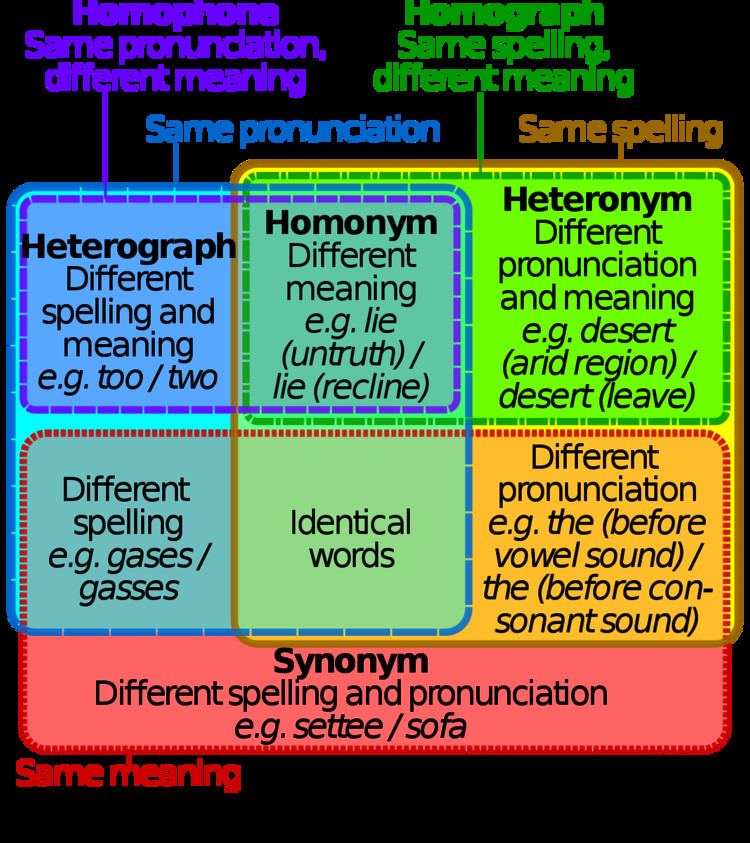 | ||
In linguistics, a homonym is one of a group of words that share the same pronunciation but have different meanings, whether spelled the same or not. A more restrictive definition sees homonyms as words that are simultaneously homographs (words that share the same spelling, regardless of their pronunciation) and homophones (words that share the same pronunciation, regardless of their spelling) – that is to say they have same pronunciation and spelling, but different meanings. The relationship between a set of homonyms is called homonymy. Examples of homonyms are the pair stalk (part of a plant) and stalk (follow/harass a person) and the pair left (past tense of leave) and left (opposite of right). A distinction is sometimes made between "true" homonyms, which are unrelated in origin, such as skate (glide on ice) and skate (the fish), and polysemous homonyms, or polysemes, which have a shared origin, such as mouth (of a river) and mouth (of an animal).
Contents
In non-technical contexts, the term "homonym" may be used (somewhat confusingly) to refer to words that are either homographs or homophones. The words row (propel with oars) and row (argument) and row (a linear arrangement of seating) are considered homographs, while the words read (peruse) and reed (waterside plant) would be considered homophones; under this looser definition, both groups of words represent groups of homonyms.
The adjective homonymous can additionally be used wherever two items share the same name, independent of how close they are or aren't related in terms of their meaning or etymology.
Etymology
The word homonym comes from the Greek ὁμώνυμος (homonumos), meaning "having the same name", which is the conjunction of ὁμός (homos), "common, same" and ὄνομα (onoma) meaning "name". Thus, it refers to two or more distinct concepts sharing the "same name" or signifier. Note: for the h sound, see rough breathing and smooth breathing.
Related terms
Several similar linguistic concepts are related to homonymy. These include:
Further examples
A further example of a homonym, which is both a homophone and a homograph, is fluke. Fluke can mean:
These meanings represent at least three etymologically separate lexemes, but share the one form, fluke.*
Similarly, a river bank, a savings bank, a bank of switches, and a bank shot in the game of pool share a common spelling and pronunciation, but differ in meaning.
The words bow and bough are examples where there are two meanings associated with a single pronunciation and spelling (the weapon and the knot); two meanings with two different pronunciations (the knot and the act of bending at the waist), and two distinct meanings sharing the same sound but different spellings (bow, the act of bending at the waist, and bough, the branch of a tree). In addition, it has several related but distinct meanings – a bent line is sometimes called a 'bowed' line, reflecting its similarity to the weapon. Even according to the most restrictive definitions, various pairs of sounds and meanings of bow, Bow and bough are homonyms, homographs, homophones, heteronyms, heterographs, capitonyms and are polysemous.
The words there, their, and they're are examples of three words that are of a singular pronunciation (in American English), have different spellings and vastly different meanings. These three words are commonly misused (or misspelled if you want to look at it that way) in American English.
Homonyms in historical linguistics
Homonymy can lead to communicative conflicts and thus trigger lexical (onomasiological) change. This is known as homonymic conflict.
